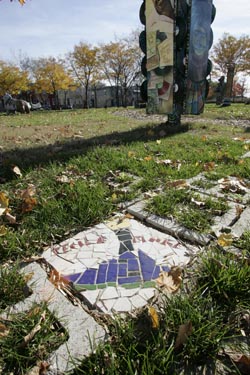Architecture students work with community to honor local heroes
| This fall, 13 architecture students worked closely with community residents to design and install a park threshold that honors 12 local heroes. The mosaic tiles have a permanent home at Baobab Park at 11th and York streets, in Philadelphia’s Fairhill community.
The project, which took roughly three weeks to design and build, was spearheaded by Sally Harrison, an associate professor of architecture and director of the Urban Workshop, an architectural group created to address the problems of rebuilding neighborhoods in the Philadelphia area. “The threshold design-build project in Baobab Park was just the first part of a 10-part project dedicated to developing short-term, medium-term and long-term design ideas for the Village of Arts and Humanities,” explained Harrison. The mosaic threshold was the entry point to an art exhibition titled “Evoking Spirit, Embracing Memory,” which honored the community’s “icons and unsung heroes who have passed away,” according to Kumani Gantt, artistic and executive director of the Village of Arts and Humanities, a group dedicated to revitalizing North Philadelphia neighborhoods. |
 Photo Betsy Manning/Temple University
A segment of the threshold at Baobab Park north of Main Campus, designed and built by Temple students, honors community leader Cecil B. Moore. The threshold features 12 different mosaic plaques to honor community heroes. In the background stands part of the sculpture exhibit that inspired the students’ work.
|
|
Harrison and 13 advanced architectural design studio students put all that they had into ensuring that their part of the project would be completed on time. “Because the exhibition was opening Sept. 15, the students hit the ground running as soon as the semester started,” Harrison said. The students, who ranged from design assistants to accomplished builders, faced a daunting task. Aside from struggling with the over 90-degree heat, how could such a diverse group of students expect to capture the essence of a community that they were not a part of? “They learned most about the community by being there, building on-site for three weeks,” said Harrison, “They talked to the neighbors who were curious and excited about something new and creative happening in the neighborhood.” But community involvement did not end at conversation. The Village Landscape team, which consists entirely of community residents, provided materials and labor to the project, and introduced the team to a city worker with access to a fire hydrant that was used to water the turf. Even some children in the community got in on the act. “A couple really energetic kids from the neighborhood joined us as we excavated rubble for the paving installation,” Harrison said. The art show officially ended in late October, but the exhibit’s bottle tree sculptures — modern, artistic takes on a Central and West African tradition — currently remain in the park, paying homage to 12 of the community’s heroes. The mosaic threshold built by architecture students also remains as a permanent testament to their lives and memories. Meanwhile, Harrison and the Urban Workshop continue to find new ways to serve the surrounding communities, including proposals for an Urban Gardening Center, an outdoor lighting scheme and a small theater. — Written by Tom Rice |
|